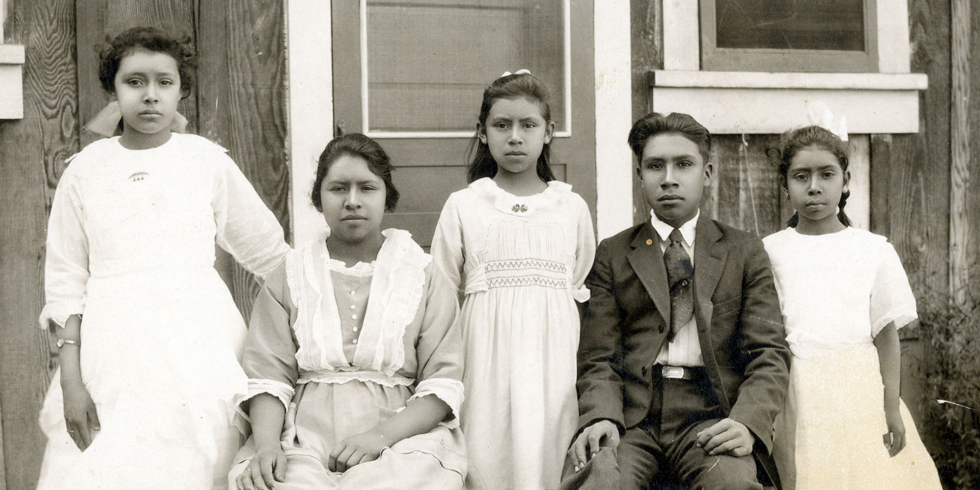Case 3 Orientation
You have opened the ninth of thirteen QR codes located throughout the gallery.
The third section of ¡Presente! is “Immigration Stories.” This section has two display cases: one in the rear, right wall, and one opposite in the middle of the gallery. They examine personal stories of Latin American immigration to the United States.
Case 3 Themes
The “Immigration Stories” cases explore Latin American immigration to the United States motivated by the search for safety, democracy, and opportunity. This is in the case in front of you. The case displayed behind you showcases the growth and impact of Puerto Rican communities across the United States.
Panel 1: Seeking Democracy and Safety:
Label Text and Object Descriptions
Civil wars, oppressive governments, and natural disasters pushed millions of people to migrate from Latin America and the Caribbean to the United States.
Throughout the 1900s, the United States supported foreign governments that favored U.S. businesses and fought communism. Sometimes U.S. foreign policy contributed to the violence and corruption driving people to migrate. The United States backed numerous dictators, including Cuba’s Fulgencio Batista and the Dominican Republic’s Rafael Trujillo. Cuban, Dominican, and many other Latino communities still feel the effects of war and revolution. Their stories reveal the human cost of immigration and the contradictions of U.S. foreign policy.
Object Group 1 Description:
Clothing worn by Cuban child immigrant who came to the United States through Operation Pedro Pan (Peter Pan). A 1960s electric, blue typewriter with white keys used by Mario Bencastro, a Salvadoran author, to write a novel about a Salvadoran immigrant’s journey to the United States.
Panel 2: Seeking Work and Opportunity:
Label Text and Object Descriptions
By 1900, the U.S. economy began to rely increasingly on workers from Latin America and the Caribbean.
Low-wage Mexican workers were essential for maintaining railroads, harvesting crops, and mining in the western United States. This was especially true after the Chinese Exclusion Act in 1882. Over the 1900s, Mexican immigrants built new communities throughout the United States.
Many others from the Dominican Republic, El Salvador, Peru, Venezuela, and elsewhere also immigrated for work and opportunity. These immigrants participate in every part of the U.S. economy, from fashion and entertainment to farming and small businesses.
Object Group 2 Description:
Black paper-backed photo from a 1940s photo album, belonging to the Afro-Cuban Grillo family. A radio featuring a rectangular, silver body with round dial buttons from the 1950s belonging to Felipe Chan-noh, a bracero, or Mexican guest worker.
Panel 3: Puerto Rico: Nation within a Nation:
Label Text and Object Descriptions
Today, over half of all Puerto Ricans live on the U.S. mainland. Still, many stay connected to the island’s people, culture, and politics.
In 1952, Puerto Rico’s constitution established it as a commonwealth (described in Spanish as “an associated free state”). This gave Puerto Ricans control over most of their internal affairs, but always at the discretion of the U.S. Congress. Because the island is an unincorporated U.S. territory, residents cannot vote in presidential elections, despite being U.S. citizens.
Commonwealth status was a compromise between independence and U.S. statehood. For many Puerto Ricans, it continues their colonial relationship with the United States.
Object Group 3 Description:
Graphic reproduction of a yellow poster featuring a man seated in a thinker’s pose, and reading, “should I go or stay?” Late 1960s–early 1970s newspaper printed by the Young Lords; a Puerto Rican youth organization founded in late 1960s Chicago.
Signature Object: Freedom Flights:
Object Label Text and Description
This photo shows the first “freedom flight” from Havana to Miami. After the Cuban Revolution, the United States organized flights for Cuban refugees. From 1965 to 1973, around 250,000 Cubans arrived on freedom flights. Many assumed they would return home.
Graphic reproduction of a black and white 1965 photograph. Shows a large crowd, many dressed in coats, standing on an airport tarmac in front of a plane that reads, “PAN AMERICAN AIRLINES”.
Directions to Next QR Code
QR code 10 is ahead on the left, about 20 feet away. QR code 11 is further ahead on your left.
